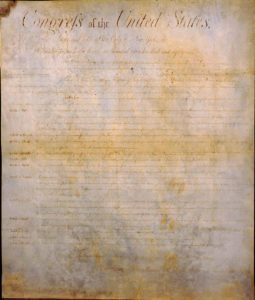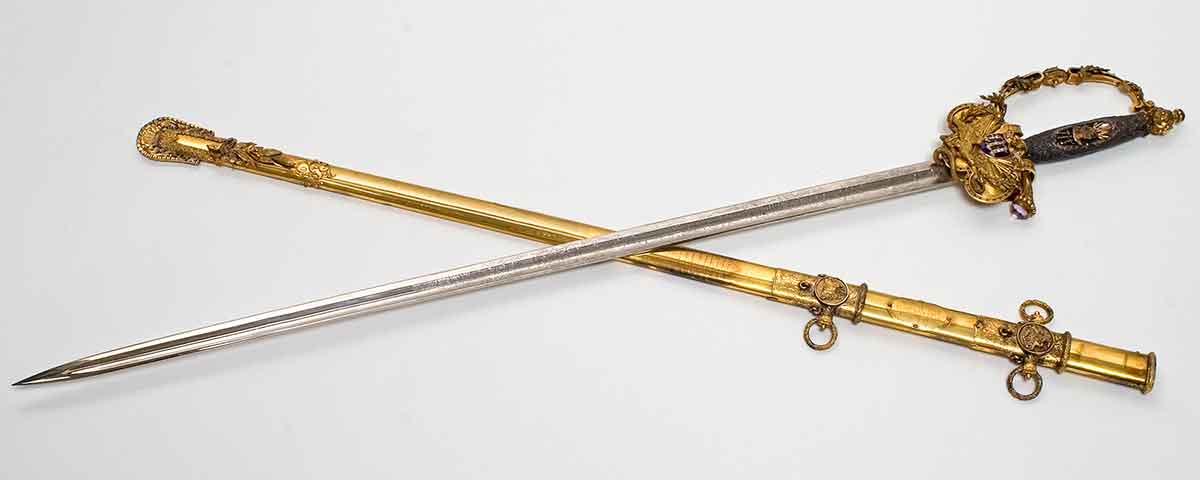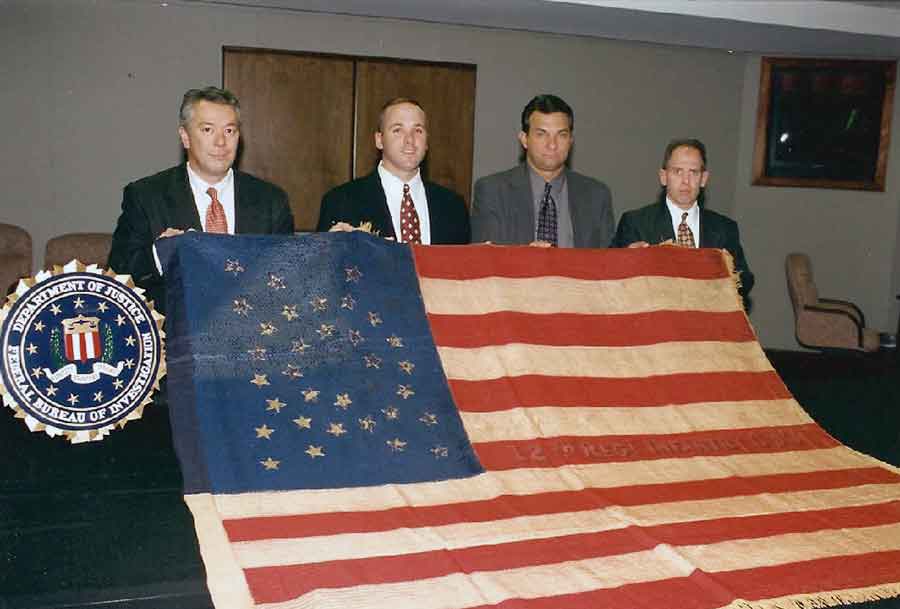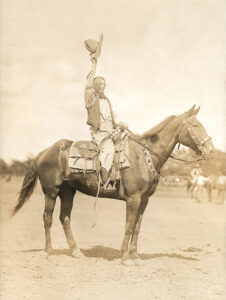Over an illustrious 20-year career, FBI agent Robert K. Wittman recovered an estimated $300 million worth of stolen artworks and historical relics. Notably, these included many precious Civil War artifacts which preserve for all of us the memory of America’s greatest struggle.
[dropcap]R[/dropcap]aised in Baltimore where his father was a high-end antiques dealer, Wittman began working for the FBI in the late 1980s and eventually focused on investigating theft of cultural items. The marketing of stolen goods would become much easier, thanks to the development of internet auctions allowing thieves to effortlessly find buyers and make lucrative sales with relative anonymity. This is especially so in the booming business of Civil War collectibles, where items either pilfered from museums or swindled from families and private collectors sometimes command millions of dollars.

Tracking down stolen historical treasures and busting those who traffic in them requires a special touch, as Wittman describes in his 2010 book Priceless. His story proves that he was a natural for the job.
In 2004, Wittman created the FBI’s Art Crime Team, a unit composed of 16 special agents trained in cultural property investigative techniques. Since the unit’s inception, it has recovered nearly 15,000 items valued at more than $160 million.
Earlier in his FBI career, Wittman had already made substantial contributions to the recovery and preservation of historical artifacts, particularly those related to the Civil War. And if his work says anything, it’s that the war’s treasured artifacts are truly vulnerable.
In the 1990s, Wittman handled numerous investigations involving everything from combat-worn uniforms and presentation weapons to personal correspondence from Union and Confederate soldiers. In each instance, the evidence led to swindlers, thieves, and unscrupulous collectors who were motivated by greed rather than a love of history.
In October 1997, for example, Wittman got a call from the collections manager at the Historical Society of Pennsylvania (HSP) in Philadelphia. During an inventory, Kristen Froehlich realized several holdings were missing. Among them were three ornate presentation swords made of gold, steel, silver, diamonds, amethyst, and rhinestones. The ceremonial blades had been presented to Union Generals Andrew Humphreys, David Birney, and George Meade on the heels of victories won by each (Meade received his at Gettysburg).
Inscribed, and therefore easily identifiable, the missing swords were worth hundreds of thousands of dollars on the collectors’ market. Froehlich provided Wittman with pictures and detailed descriptions, and the legwork began.
He started by interviewing the HSP’s entire staff, with the exception of one person who phoned in sick—society custodian Earnest Medford.
A week later, Wittman got tips from presentation sword expert Bruce Bazelon. The Poconos-based militaria dealer implicated a Philadelphia history buff, George Csizmazia. According to the dealer, Csizmazia had offered to sell him a presentation sword that he distinctly remembered seeing in the HSP collection.
Wittman followed up on Csizmazia and was amazed by what he found. During a search by warrant of the collector’s suburban Philadelphia home, Wittman encountered not just three presentation swords, but 25. Csizmazia also had in his possession about 50 antique firearms and a staggering assortment of 18th- and 19th-century Americana. The cache was so big that Wittman and his partner needed backup to process the growing mound of criminal evidence.
Easily worth millions, Csizmazia’s stash included a rifle used by John Brown during his October 1859 raid on Harpers Ferry and a gold watch bearing the inscription: “Presented to Maj. Gen. George G. Meade, USA as a token of esteem and regard from his friend E.P. Dorrl, Gettysburg, July 1st, 2nd, 3rd. VICTORY.”
The game was up for Csizmazia, who admitted to having paid Medford, the HSP custodian, $8,000 over an eight-year period to smuggle an estimated $3 million in artifacts from the society’s collection. Csizmazia received a maximum three-year sentence; Medford, four months in federal prison.
Though a win for Civil War enthusiasts and history devotees in general, the convictions in the HSP case were but a drop in a sea of cultural crime. For every thief the FBI puts behind bars, there is another still free to ply his or her trade. Within a year of closing the Csizmazia file, Wittman was in pursuit of another offender, this one peddling a sacred piece of Civil War history: the 12th Regiment Corps d’Afrique’s battle flag.
The 12th was a U.S. Colored Troops outfit raised in Louisiana—one of the first to see heavy fighting in the war. In May 1863, the 12th participated in the Union assault on Port Hudson along the Mississippi River. Five of its men died carrying the flag. Adorned with 35 gold stars and the inscription, 12th REG. INFANTRY CO’ A, it is just one of five U.S.C.T. regimental Civil War flags in existence today.
Appropriately dubbed “the Blood Cloth,” the 12th’s standard hung for decades at West Point as part of the U.S. Army archives. Then, in the mid-1970s, curators put the flag on loan for an exhibition in South Carolina. The Blood Cloth never made it to its destination.
More than 20 years later, Wittman learned a seller was shopping the missing flag on the black market. Posing as a buyer, he convinced the suspect, Charles Wilhite, to fly to Philadelphia to make a sale.
Wittman met Wilhite in a motel room with hidden cameras and three FBI agents waiting to seize their mark. During a few minutes of conversation Wilhite incriminated himself, admitting he knew the flag was stolen property. After Wilhite had accepted Wittman’s cash offer of $28,000, the team arrested him.
[quote style=”boxed” float=”left”]‘The artistic and historical artifacts in museums and archives belong to all of us and I want to keep it that way.’ -Robert K. Wittman[/quote]
Of course, outright thieves and black market dealers aren’t the sole threats facing the Civil War historical community. Shortly after Wilhite’s arrest, Wittman started investigating a pair of high-brow con artists who had made a fortune bilking descendants of notable Civil War figures.
Partners in a militaria brokerage—the American Ordnance Preservation Association—Russell Pritchard III and George Juno were respected names in the field, both appraisers on the popular PBS series Antiques Roadshow.
Wittman’s investigation revealed that George E. Pickett V—the great-great-grandson of the Confederate general—had sued Pritchard and Juno for fraud. At the time, the duo had been helping the mayor of Harrisburg, Pa., acquire items for the town’s new Civil War museum. Using the credibility gained with the Harrisburg project and their appearaces on Antiques Roadshow, Pritchard and Juno convinced the Pickett family to sell them extremely rare heirlooms.
The items were the kepi and sword Pickett had worn at Gettysburg; a map he had sketched hours before his disastrous charge; his officer’s commission papers; personal correspondence; and a blood-stained jacket sleeve. Based on a fraudulent appraisal, Pritchard and Juno paid the family $87,000 for this historical bonanza, which they in turn sold to the Harrisburg museum for $850,000.
Wittman uncovered similar cases wherein Pritchard and Juno defrauded collectors and descendants of prized Civil War artifacts. For example, the duo approached the Meade family under the pretense of working for the Harrisburg museum, paying $180,000 for the general’s exquisite .44-caliber Remington pistol. They subsequently sold it, not to the museum as promised, but instead to a private collector for $360,000.

Wittman soon had enough evidence to arrest and charge the two with multiple counts of fraud. Pritchard went to prison for a year. Juno spent a few months in a halfway house, as did Pritchard’s father for his involvement. Their sentences were light, yet they resonated with the public and generated tips that led to more thieves and con artists.
Wittman’s crowning investigative achievement began in 2003, but the roots of the crime trace back to April 1865 when 90,000 troops under Union Maj. Gen. William Tecumseh Sherman amassed outside Raleigh, N.C. Lee had surrendered, and Confederate officials were on the run, abandoning the North Carolina capital without a fight. Sherman’s soldiers ransacked the capital, stealing souvenirs, art, and historical documents—notably, North Carolina’s copy of the 1789 U.S. Bill of Rights, hand-drafted on vellum.
One of 14 copies issued to each state and the federal government, it was priceless even by 19th-century standards, but in April 1865 was “liberated” as a spoil of war by an Ohio soldier in Sherman’s ranks.
On a visit to Ohio a year after the war, Indianapolis businessman Charles Shotwell bought the document from the soldier for $5. The parchment resurfaced in 1897 in a published interview with Shotwell, and again in 1925 when he unsuccessfully tried to sell it back to North Carolina.
Shotwell’s granddaughters, Anne Bosworth and Sylvia Long, eventually inherited the piece and, in 1995, made discreet overtures to sell it, allegedly approaching wealthy potential buyers Steven Spielberg, Michael Jordan, and Oprah Winfrey to no avail.
Wittman, notified in 2003 that someone had offered to sell it to the National Constitution Center for $4 million, created a carefully orchestrated sting with the help of the National Constitution Center. He intercepted the long-missing document, and returned it to its rightful home.
Wittman summarized his undeniable contributions to preserving the memory of America’s Civil War: “The artistic and historical artifacts in museums and archives belong to all of us and I want to keep it that way.”
Michael G. Williams, who writes from Glen Arm, Md., is a frequent contributor to America’s Civil War.






